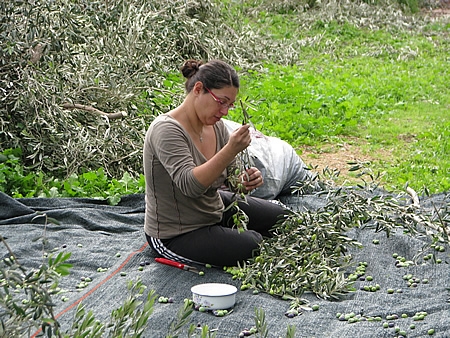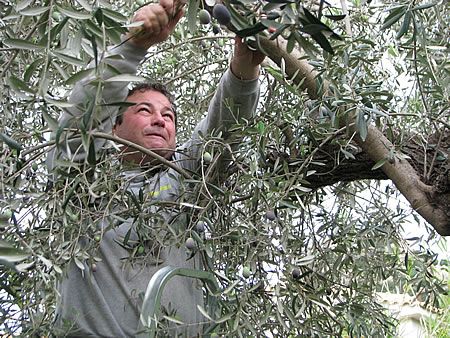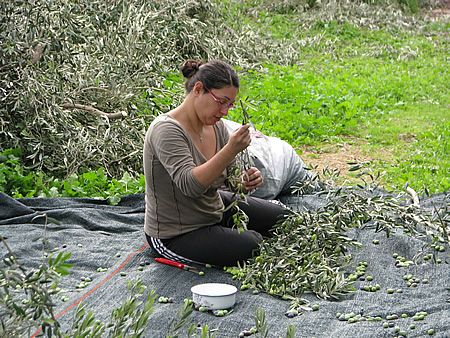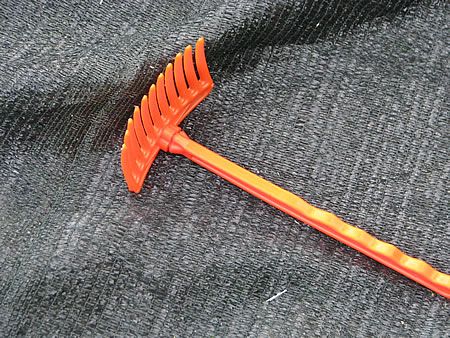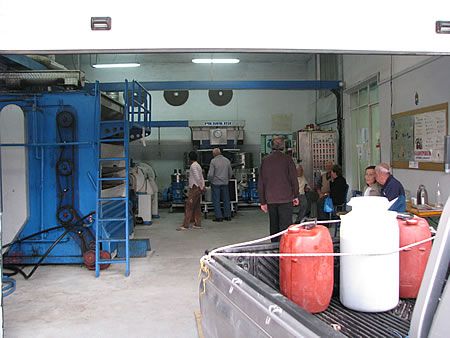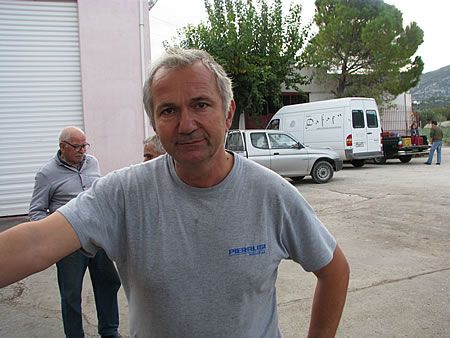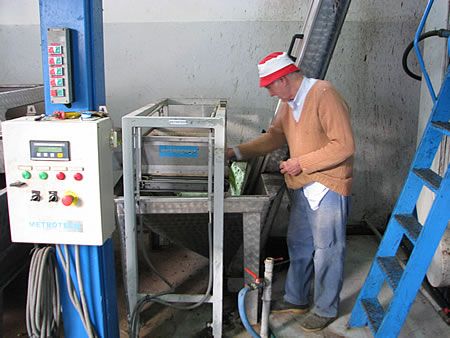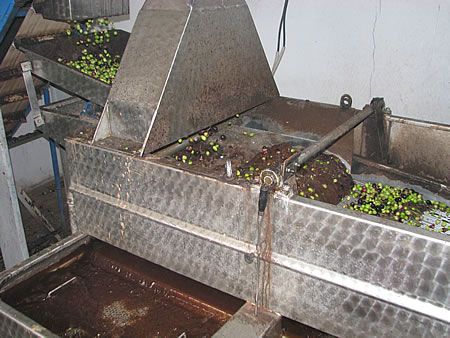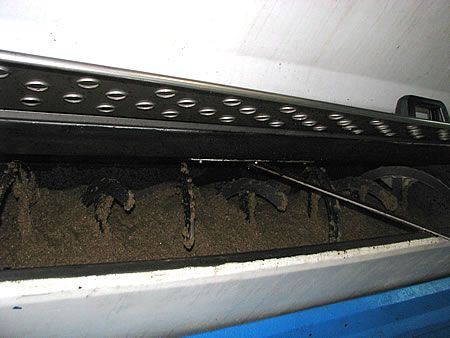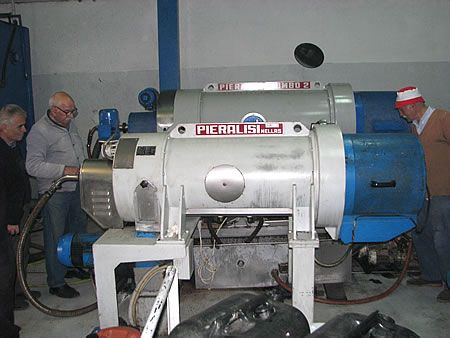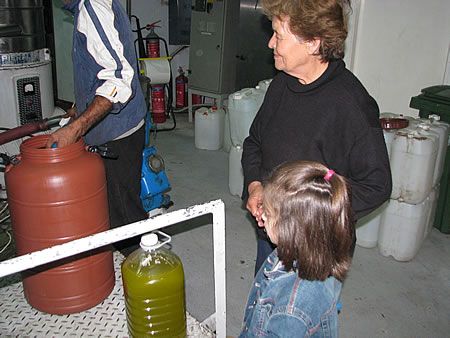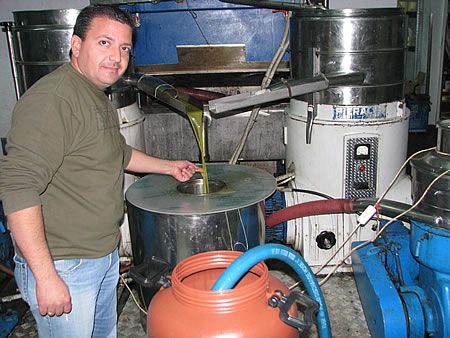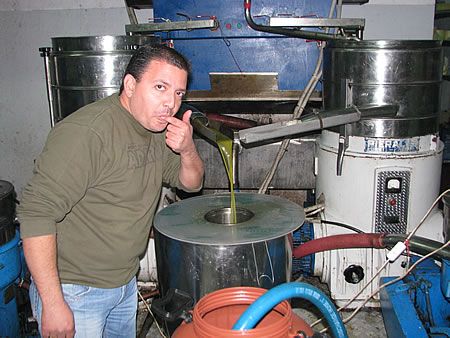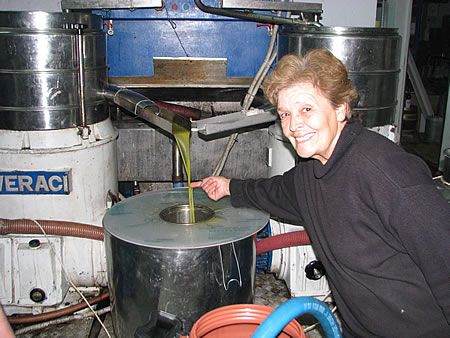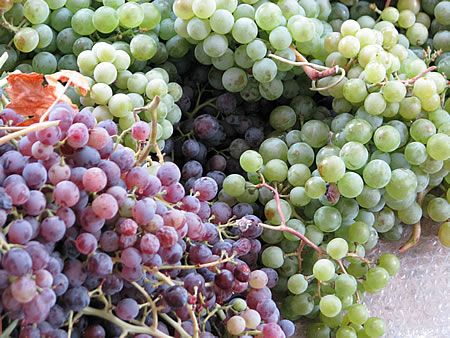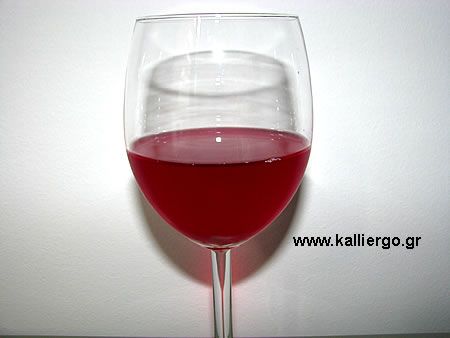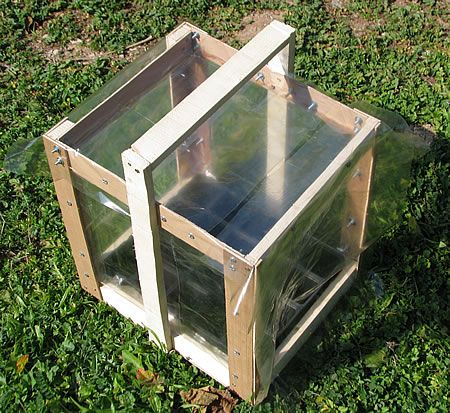In this article I describe how I make homemade olive oil in Greece. The whole process from picking the olives to the olive mill and making homemade olive oil. I hope you find it useful, answer your questions and encourage you to make your own homemade olive oil. You will find that it’s taste is nothing close to the olive oil we buy from the supermarket.
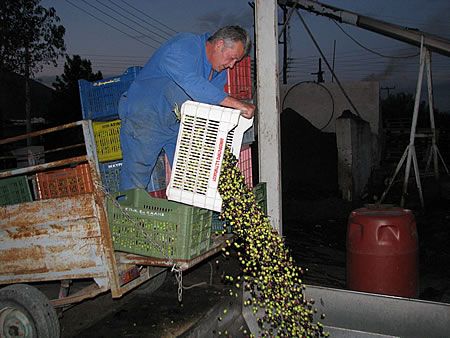
On the estate we have 4 relatively large olive trees. To be honest, we don’t take much care of them. Not at all is the right thing to do. However, they are very generous to us. Every year they are full of olives.
In previous years, we snubbed our olives. Some years some neighbors would come and pick our olives. Other years we just let them fall down and go to waste.
But this year, my wife Tatiana and I decided to pick them. I have to admit that this year was the first time I actually picked olives. I actually helped my father pick the olives several years ago, but that doesn’t count because I did it as a chore.
Olive picking
We decided to pick the olives in two phases. To pick the fruit from the first two olives now and in late December or January the fruit from the remaining two.
We started picking the olives from the first olive tree on Monday. Along with the harvesting I did the pruning. I hope I did it right. My invaluable helper on how to prune the olive was a book. The book “Pruning of fruit trees and shrubs” by Jean-Yves Prat. In this book, in addition to information on pruning the olive tree, you can find information and useful diagrams for many other trees.
I have to admit that olive pruning is a difficult and time-consuming process if you don’t have the right tools. As amateurs that we are, and because we have very few olive trees, we don’t have the right tools, so we had quite a hassle.
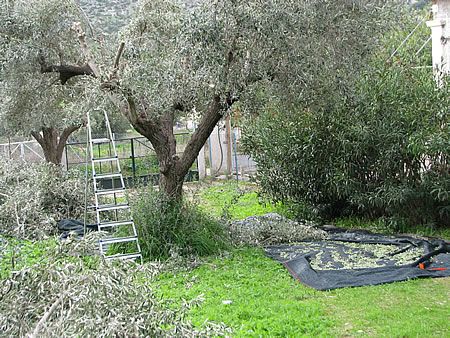
Olive trees
At first we laid a piece of shade net under the olive tree. Normally we would have had to use oil cloth, but we didn’t have any and didn’t want to go to the extra expense. Either way, the shade net did a fine job.
Pruning – picking olives – Not easy
I cut and knocked down the olive branches that needed to be removed and then we picked the olives from them. The first day we picked them by hand. Tatiana and I worked from morning until the sun went down and we had only managed to pick half of the olives from the first olive tree. Not to mention the physical fatigue. But we had the satisfaction of making our own olive oil.
Tatiana removes the olives in her own way
Olive combs
On the second day I purchased two valuable tools from the local hardware store. Two olive combs. With the combs you can remove the olives with quick movements. They are plastic and resemble small rakes. We use them like combing the branches. Any olives they come across are cut off the stems and fall off.
Comb for picking olives
With olive combs, the rate of harvesting has improved at least 10 times.
On the second day, we finished the first olive tree and harvested half of the olives from the second, working until noon.
On the third day, we harvested the remaining olives and finished pruning the second olive tree. All this until early afternoon.
Sacks
We put the olives we picked into sacks. Normally the sacks should be made of natural material. Unfortunately, I only found plastic bags. In total, in three days we harvested 14 saks of olives.
At this point, I would like to publicly express my admiration to Tatiana for her valuable help. Few women today would be involved in olive picking. Most would prefer to have a coffee with their friends or paint their nails. I could be wrong, but that’s the impression I have.
At the olive mill
As an inexperienced person, I didn’t know of an olive mill where I would take the olives to be made into oil. So I used the internet to search. In the area of Koropi, Greece that serves me, I found only one olive mills. The olive mill with the name Antonis Davaris. I found no web site, but various references in market guides. There may be more than one mill in the Koropi, Greece area. I am referring to the one I found via the internet.
I called them. The polite female voice answered all my questions patiently. I would take my own oil, not what was coming out at the time. I would get as much oil as my own olives would provide. I made an appointment for the day after I called.
The appointment was for 4 o’clock in the afternoon. I loaded the 14 sacks of olives into the car and set off on the journey to the unknown…
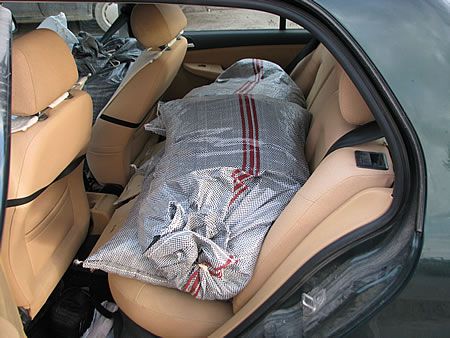
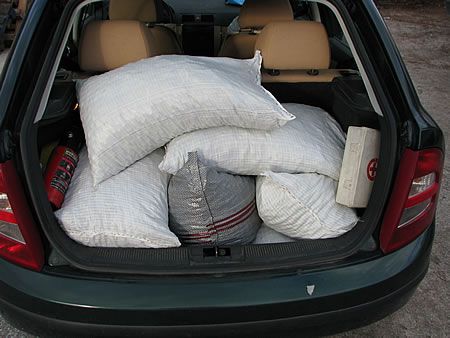
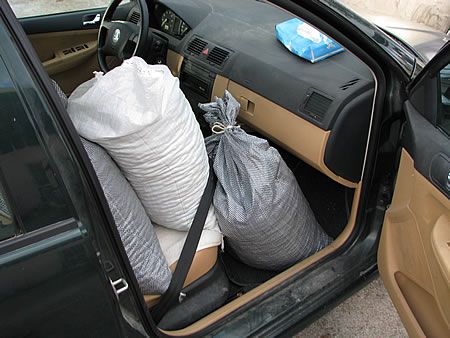
Antonis Davaris olive mill
Arriving at the olive mill, the atmosphere was much better than I could have ever imagined. The whole setting felt like a small celebration.
Cars, farm trucks, small trucks, all had been drafted to transport the precious fruit to the place where the oil would be made.
View from the oil mill of Mr. Antonis Davaris
The welcoming and unpretentious space of the mill was full of people who had brought their harvest. Some were (briefly) alone, others had come with their families. Some were known to each other and were teasing and praising each other.
I didn’t know anyone and just enjoyed the scene I was watching, gluttonously soaking up every moment.
My first meeting with Mr. Anthony Davaris
A gentleman approached me. He started asking me various questions and explaining the process. He obviously understood that I was new to the sport.
-I said are you a customer or a customer of the shop?
– I am the owner he replied.
Mr. Antonis Davaris, owner of the olive press
Mr. Skomboulis, omnipresent and all-powerful
I knew I had come to the right place. I felt beautiful and familiar.
The process at the olive mill
I don’t know if the following procedure is common to all olive mills but I will tell you what happened at the olive mill of Mr. Antonis Davaris in Koropi, Greece.
The whole process, from picking up the fruit to getting your own oil, takes about 2 hours.
Receiving the olives

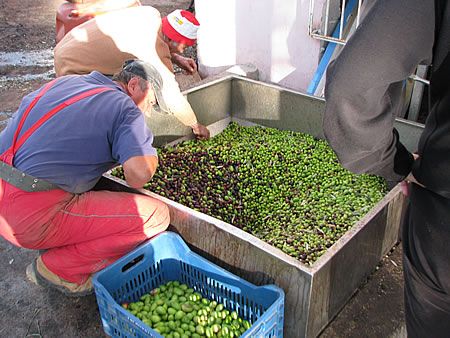
You empty the olives into a hopper. The olives are weighed and the automated process begins. You are shown the result of the weighing.
Defoliation
The leaves and twigs are removed from the olives you have picked.
Washing
Defoliation and washing of the fruit
Washing the fruit removes all foreign matter which, if ground, gives the oil an unpleasant taste.
Breaking
The breaking of the olives creates the olive paste and contributes to the extraction of olive oil from the cells of the mesocarp.
Mashing
Mashing of the olive yeast
Mashing is the phase of releasing the olive oil from the olives and combining the smaller drops into larger ones during the stirring process. The duration of maceration must be at least 30 minutes.
Centrifugation
Centrifugation of the olive paste
Centrifugation is the process of extracting the olive oil from the olive paste based on the difference in specific gravity between the components of the olive paste (water, oil, solids).
Separation of olive oil
The separation of olive oil is carried out for the final purification of the olive oil.
Separation of waste water
The effluent separator is the safety of the miller in the event of a malfunction of the decanter.
Olive oil separation
The experienced generation introduces the new generation to the production of olive oil. From grandmother to granddaughter
The great moment! The oil comes out! Panagiotis (another amateur producer I met at the olive mill) is preparing to taste his oil…
Panagiotis tasting his oil!
She is over 70 years old and picked more than 800 kilos of olives by herself!
The separation of the olive oil is done for the final purification of the olive oil.
Storage
Storage is done in containers or stainless steel tanks. Since I didn’t have my own containers, the mill gave them to me and charged a reasonable price.
The economics – Is it worth it or not to pick olives and make your homemade oil?
Tatiana and I picked 335.80 kgr of olives.
They yielded 35 kgr of oil. (Why so little? From what we were told at the olive mill, we should be watering the olives in the summer. Next year we will know better).
Notes: The ratio of olives to olive oil is between 1:5 to 1:15. The final ratio depends on the variety of olive, the time of harvest, and the care the trees have had.
The olive mill charged EUR 0,10 per kgr of fruit. So we paid 33.58 Euro + 0.19 Euro (for the pruning rights) + 11% VAT = 37.48 Euro.
Each kgr of olive oil cost us 1.07 Euro. In the supermarket we would have bought it for between 5 and 6 Euros.
So if you pick your own olives and don’t count the labor costs, then it’s definitely worth it.
Let’s assume that you have hired an assistant for the harvest. Instead of 3 days, you will need 2. The average daily cost for the assistant will be 70 Euros.
So: 2 days of help x 70 Euro = 140 Euro (A)
Cost of olive oil production: 37,48 Euro (B)
Total cost (A)+(B) = 177,48 Euro
Production: 35 kg.
Cost per kg: 177,48 Euro / 35 kg = 5,07 Euro per kg.
As you can see, if you use an assistant, you lose the advantage of the low price. The cost per kilo of the olive oil you produce is almost the same as the price you would pay if you bought it from the supermarket.
Enough with the calculations!
Don’t get into the logic of is it worth it or not worth it to pick your olives and make your own homemade olive oil!
The olive oil and the olives are yours. The olive oil you produce is unique and priceless. If you can pick your own olives and produce your own olive oil, do it without a second thought. You know what you are making, you know where it comes from, you know how much effort it took.
Enjoy your homemade olive oil!
Tags: DAVARIS • HARVESTING • I MAKE • KOROPI • OLIVE MILL • OLIVE OIL • OLIVE TREE • OLIVES

